Abstract
The metal-binding affinity of the anionic poly-γ-d-glutamyl capsule of Bacillus licheniformis was investigated by using Na+, Mg2+, Al3+, Ca2+, Cr3+, Mn2+, Fe3+, Ni2+, and Cu2+. Purified capsule was suspended in various concentrations of the chloride salts of the various metals, and after dialysis the bound metals were analyzed either by graphite furnace atomic absorption spectroscopy or by inductively coupled plasma-mass spectrometry. Exposure of purified capsule to excess concentrations of Na+ revealed it to contain 8.2 μmol of anionic sites per mg on the basis of Na binding. This was confirmed by titration of the capsule with HCl and NaOH. Other metal ions were then added in ionic concentrations equivalent to 25, 50, 75, 100, 200, and 400% of the available anionic sites. The binding characteristics varied with the metal being investigated. Addition of Cu2+, Al3+, Cr3+, or Fe3+ induced flocculation. These metal ions showed the greatest affinity for B. licheniformis capsule in competitive-binding experiments. Flocculation was not seen with the addition of other metal ions. With the exception of Ni2+ and Fe3+ all capsule-metal-binding sites readily saturated. Ni2+ had low affinity for the polymer, and its binding was increased at high metal concentrations. Fe3+ binding resulted in the development of rust-colored ferrihydrite which itself could bind additional metal. Metal-binding characteristics of B. licheniformis capsule appear to be influenced by the chemical and physical properties of both the capsule and the metal ions.
Full text
PDF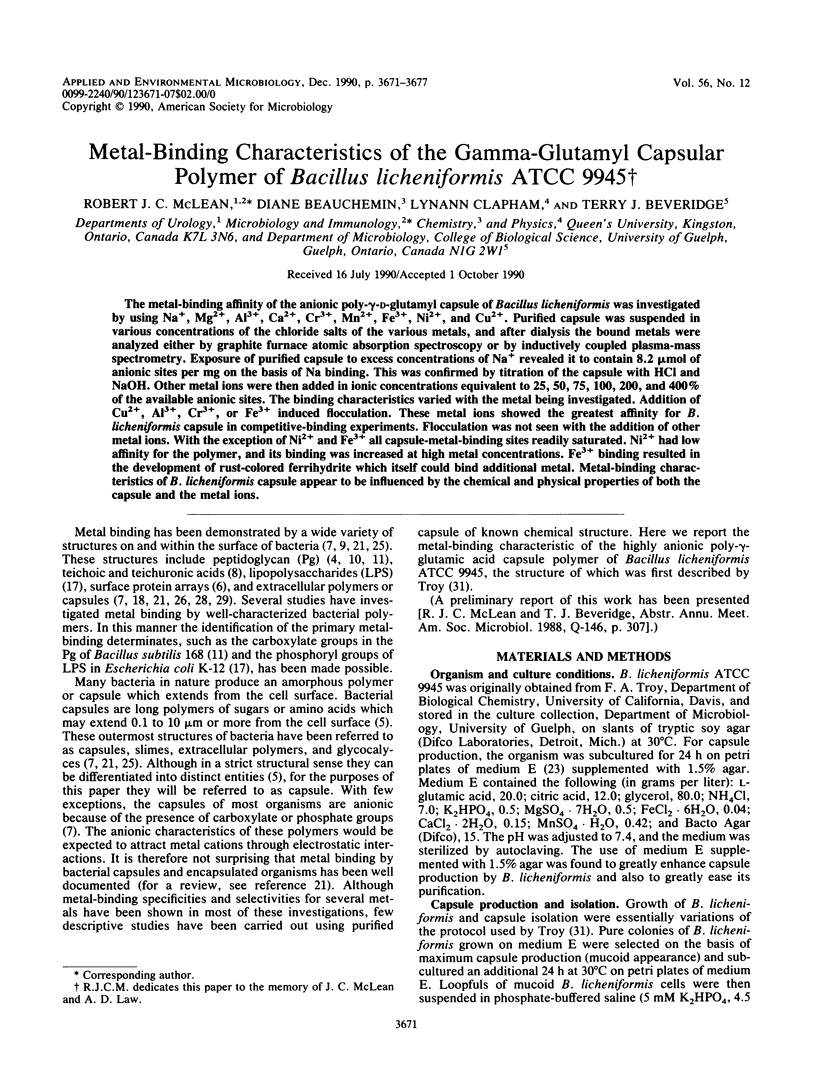
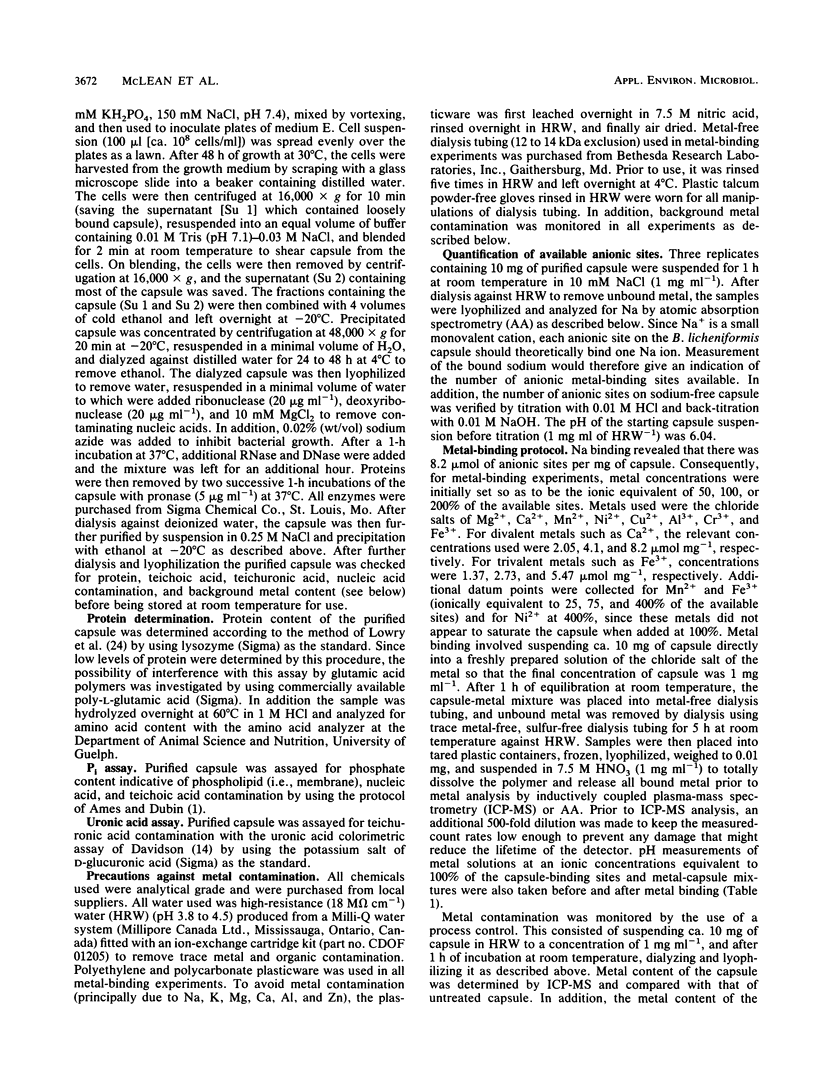
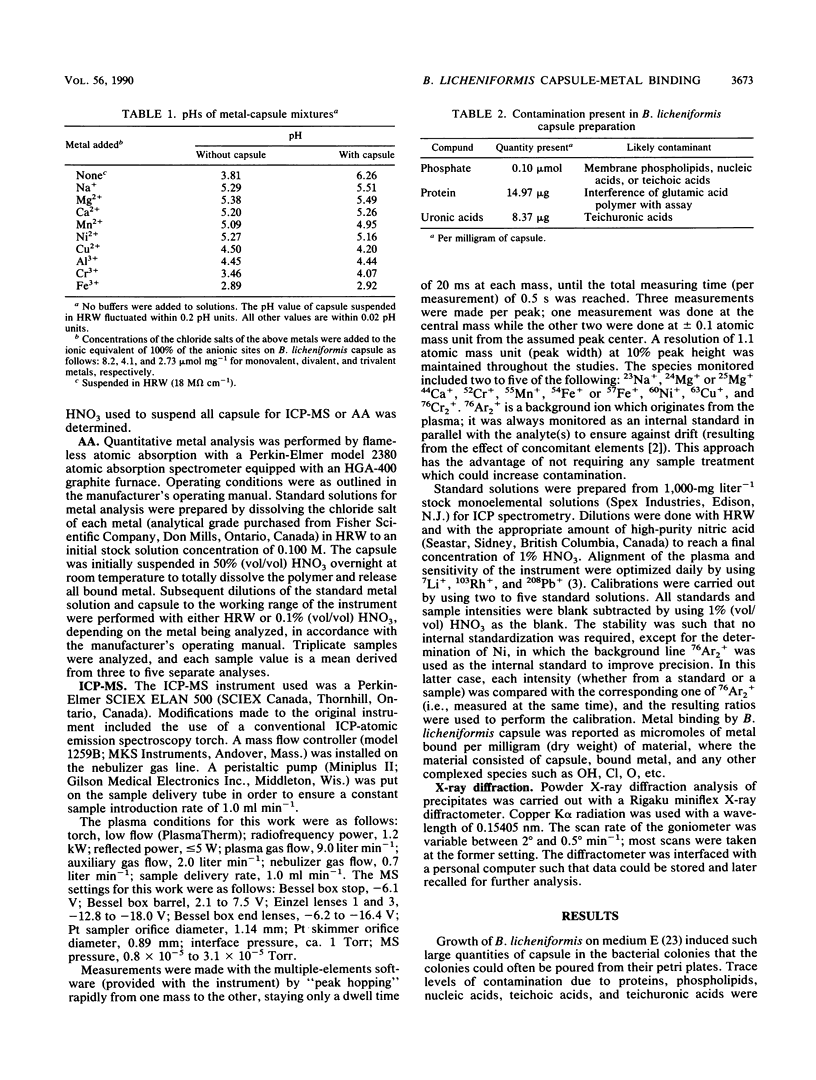


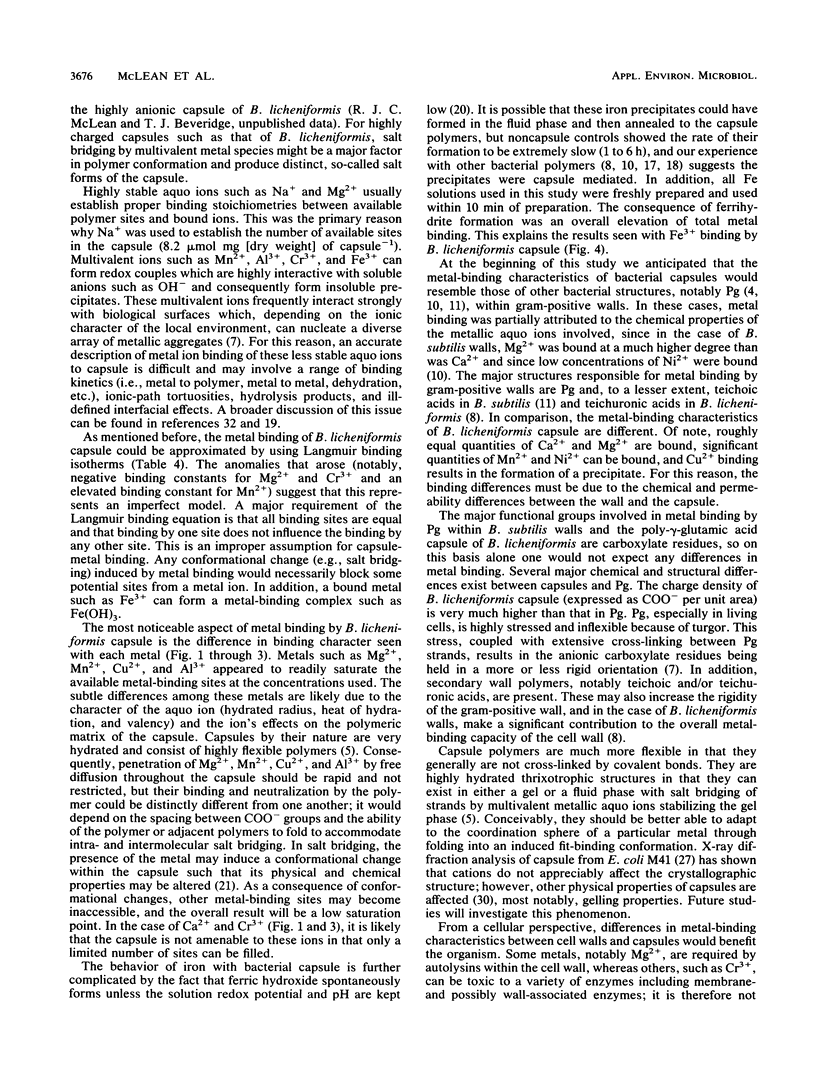
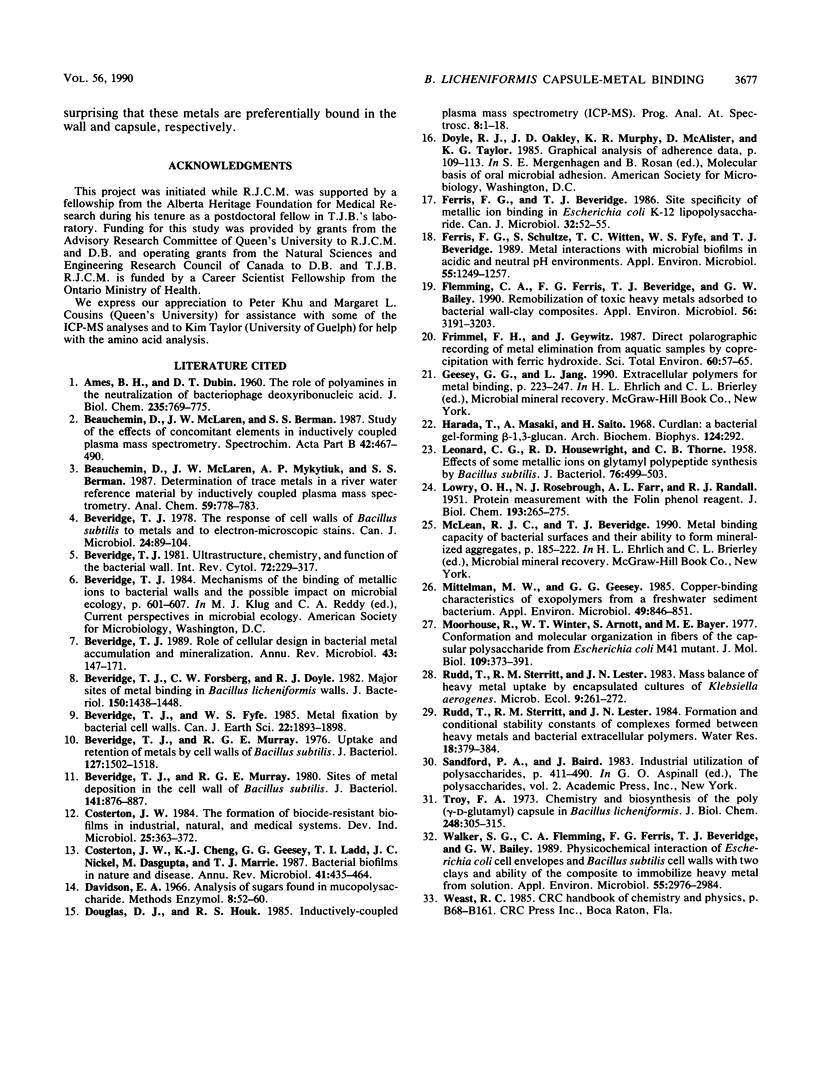
Selected References
These references are in PubMed. This may not be the complete list of references from this article.
- AMES B. N., DUBIN D. T. The role of polyamines in the neutralization of bacteriophage deoxyribonucleic acid. J Biol Chem. 1960 Mar;235:769–775. [PubMed] [Google Scholar]
- Beveridge T. J., Forsberg C. W., Doyle R. J. Major sites of metal binding in Bacillus licheniformis walls. J Bacteriol. 1982 Jun;150(3):1438–1448. doi: 10.1128/jb.150.3.1438-1448.1982. [DOI] [PMC free article] [PubMed] [Google Scholar]
- Beveridge T. J., Murray R. G. Sites of metal deposition in the cell wall of Bacillus subtilis. J Bacteriol. 1980 Feb;141(2):876–887. doi: 10.1128/jb.141.2.876-887.1980. [DOI] [PMC free article] [PubMed] [Google Scholar]
- Beveridge T. J., Murray R. G. Uptake and retention of metals by cell walls of Bacillus subtilis. J Bacteriol. 1976 Sep;127(3):1502–1518. doi: 10.1128/jb.127.3.1502-1518.1976. [DOI] [PMC free article] [PubMed] [Google Scholar]
- Beveridge T. J. Role of cellular design in bacterial metal accumulation and mineralization. Annu Rev Microbiol. 1989;43:147–171. doi: 10.1146/annurev.mi.43.100189.001051. [DOI] [PubMed] [Google Scholar]
- Beveridge T. J. The response of cell walls of Bacillus subtilis to metals and to electron-microscopic stains. Can J Microbiol. 1978 Feb;24(2):89–104. doi: 10.1139/m78-018. [DOI] [PubMed] [Google Scholar]
- Beveridge T. J. Ultrastructure, chemistry, and function of the bacterial wall. Int Rev Cytol. 1981;72:229–317. doi: 10.1016/s0074-7696(08)61198-5. [DOI] [PubMed] [Google Scholar]
- Costerton J. W., Cheng K. J., Geesey G. G., Ladd T. I., Nickel J. C., Dasgupta M., Marrie T. J. Bacterial biofilms in nature and disease. Annu Rev Microbiol. 1987;41:435–464. doi: 10.1146/annurev.mi.41.100187.002251. [DOI] [PubMed] [Google Scholar]
- Ferris F. G., Beveridge T. J. Site specificity of metallic ion binding in Escherichia coli K-12 lipopolysaccharide. Can J Microbiol. 1986 Jan;32(1):52–55. doi: 10.1139/m86-010. [DOI] [PubMed] [Google Scholar]
- Ferris F. G., Schultze S., Witten T. C., Fyfe W. S., Beveridge T. J. Metal Interactions with Microbial Biofilms in Acidic and Neutral pH Environments. Appl Environ Microbiol. 1989 May;55(5):1249–1257. doi: 10.1128/aem.55.5.1249-1257.1989. [DOI] [PMC free article] [PubMed] [Google Scholar]
- Flemming C. A., Ferris F. G., Beveridge T. J., Bailey G. W. Remobilization of toxic heavy metals adsorbed to bacterial wall-clay composites. Appl Environ Microbiol. 1990 Oct;56(10):3191–3203. doi: 10.1128/aem.56.10.3191-3203.1990. [DOI] [PMC free article] [PubMed] [Google Scholar]
- Harada T., Misaki A., Saito H. Curdlan: a bacterial gel-forming beta-1,3-glucan. Arch Biochem Biophys. 1968 Mar 20;124(1):292–298. doi: 10.1016/0003-9861(68)90330-5. [DOI] [PubMed] [Google Scholar]
- LEONARD C. G., HOUSEWRIGHT R. D., THORNE C. B. Effects of some metallic ions on glutamyl polypeptide synthesis by Bacillus subtilis. J Bacteriol. 1958 Nov;76(5):499–503. doi: 10.1128/jb.76.5.499-503.1958. [DOI] [PMC free article] [PubMed] [Google Scholar]
- LOWRY O. H., ROSEBROUGH N. J., FARR A. L., RANDALL R. J. Protein measurement with the Folin phenol reagent. J Biol Chem. 1951 Nov;193(1):265–275. [PubMed] [Google Scholar]
- Mittelman M. W., Geesey G. G. Copper-binding characteristics of exopolymers from a freshwater-sediment bacterium. Appl Environ Microbiol. 1985 Apr;49(4):846–851. doi: 10.1128/aem.49.4.846-851.1985. [DOI] [PMC free article] [PubMed] [Google Scholar]
- Moorhouse R., Winter W. T., Arnott S., Bayer M. E. Conformation and molecular organization in fibers of the capsular polysaccharide from Escherichia coli M41 mutant. J Mol Biol. 1977 Jan 25;109(3):373–391. doi: 10.1016/s0022-2836(77)80018-1. [DOI] [PubMed] [Google Scholar]
- Troy F. A. Chemistry and biosynthesis of the poly( -D-glutamyl) capsule in Bacillus licheniformis. I. Properties of the membrane-mediated biosynthetic reaction. J Biol Chem. 1973 Jan 10;248(1):305–315. [PubMed] [Google Scholar]
- Walker S. G., Flemming C. A., Ferris F. G., Beveridge T. J., Bailey G. W. Physicochemical interaction of Escherichia coli cell envelopes and Bacillus subtilis cell walls with two clays and ability of the composite to immobilize heavy metals from solution. Appl Environ Microbiol. 1989 Nov;55(11):2976–2984. doi: 10.1128/aem.55.11.2976-2984.1989. [DOI] [PMC free article] [PubMed] [Google Scholar]


